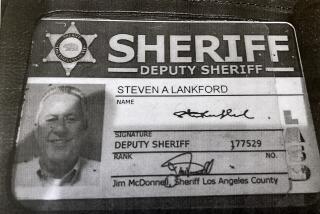FBI Sends Experts on Chinese Spying to Los Alamos Lab
WASHINGTON — The FBI has sent a team of experts on Chinese spying techniques to Los Alamos National Laboratory in a widening investigation of a former lab scientist who is suspected of passing vast amounts of nuclear weapon secrets to Beijing.
The stepped-up FBI investigation is specifically looking at why Wen Ho Lee, the chief suspect in the espionage case, downloaded highly classified computer programs and data onto an unprotected office network in several distinct bursts between 1983 and 1995.
Investigators said the unusual pattern suggested Lee might have been trying to meet specific Chinese military intelligence collection requirements.
“He made a couple of big hits, and they were infrequent,” the official said.
But investigators have yet to determine if Lee printed out the top secret files, copied them onto disks, sent them out as e-mail, or let someone else use his password to gain access to the results of years of America’s most secret nuclear weapon research and design.
Employees and visitors to Los Alamos in New Mexico are not normally searched. Until the Energy Department strengthened computer security earlier this month, nothing except the rules barred someone from sending unauthorized e-mail or walking out the door with classified computer material in a briefcase.
Lee was fired from Los Alamos on March 8 for violating lab security rules, and his Los Angeles lawyer, Mark Holscher, is working with government lawyers in an attempt to persuade them not to bring charges. Lee’s defenders insist he is a government scapegoat, not a spy for China.
John J. Kelly, the U.S. attorney in Albuquerque, who is in charge of the case, disputed a Los Angeles Times story that appeared Thursday. The story quoted a senior Clinton administration official who said the FBI was planning to arrest Lee within 10 days for unauthorized disclosure of classified materials.
In a telephone interview, Kelly said the official’s comments were “inaccurate, unauthorized and a disservice to the ongoing investigation. To date, Dr. Lee and his counsel are cooperating with the FBI and the Department of Justice.”
Kelly said it was premature to discuss criminal charges, but he declined to elaborate.
The transfer of classified computer files with defense information is illegal under U.S. espionage laws if the intent is to harm the United States. A separate statute covers delivery of such information to aid a foreign government.
Sen. Richard C. Shelby (R-Ala.), chairman of the Senate Select Committee on Intelligence, said in an interview Thursday, after his panel grilled FBI Director Louis J. Freeh on the espionage case, that he fears the worst.
“They don’t know at this point what went out of the lab,” Shelby said. “But if somebody is going to do this, and put it on a personal computer, you have to assume a lot of it is gone.
“I’m afraid all of this will show up in a few years to enhance the Chinese nuclear program.”
Officials said the computer “codes,” or programs, included the chronological records of the mathematical computations that the physicists and other scientists used to develop, test and build nuclear bombs, warheads and other devices during the Cold War.
Lee worked on creating or analyzing such complex codes for most of his 20-year career at Los Alamos. In 1997, for example, he was assigned to help update the programs used for the lab’s “stockpile stewardship” program, which aims to ensure that nuclear weapons in the U.S. arsenal remain reliable without underground testing.
Several Energy Department officials said they could think of no reason why Lee needed to move the extensive nuclear weapon files to an insecure system to do his job. His office contained both a computer workstation for classified work and a separate desktop computer for unclassified work.
“This is not something you do for convenience’s sake,” one official said.
But one scientist who has followed the case closely said Lee still may have a reasonable explanation.
“If he’s the greatest spy of the 20th century, why is he still out there mowing his lawn?” the scientist asked. “In the old days, when the super-spies got wind of the feds coming, they disappeared and showed up years later in Moscow.”
Other questions are equally puzzling. The FBI only discovered the pilfered nuclear weapon files, for example, because Lee gave them permission to examine his personal computer after he was fired.
Officials said the FBI first sought to check Lee’s computer after he was identified as a potential spy in 1996. But Justice Department lawyers reportedly said a warrant would be required because lab computers did not carry warnings that they were subject to search as government property.
Another mystery is the role of Lee’s wife, Sylvia, a former administrative assistant at Los Alamos.
She worked as an unpaid FBI informant from 1985 to 1991, and met with FBI agents seven times during that period to pass information about Chinese delegations visiting Los Alamos. She also mailed information to the bureau. The FBI has ruled her out as an espionage suspect.
Counterintelligence experts say Beijing assigns students, scientists, officials and other visitors to America to collect potentially helpful information, rather than relying on trained agents.
“They’re about the best in the world in gaining intelligence by vacuuming information all over the place and painstakingly putting it together,” said one official. “Almost every person who comes over, if they’re not given specific requirements, they’re at least debriefed when they go back.”
More to Read
Sign up for Essential California
The most important California stories and recommendations in your inbox every morning.
You may occasionally receive promotional content from the Los Angeles Times.











